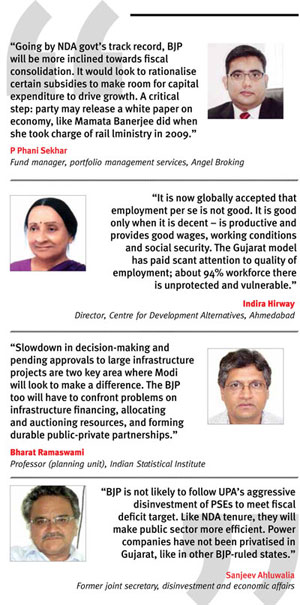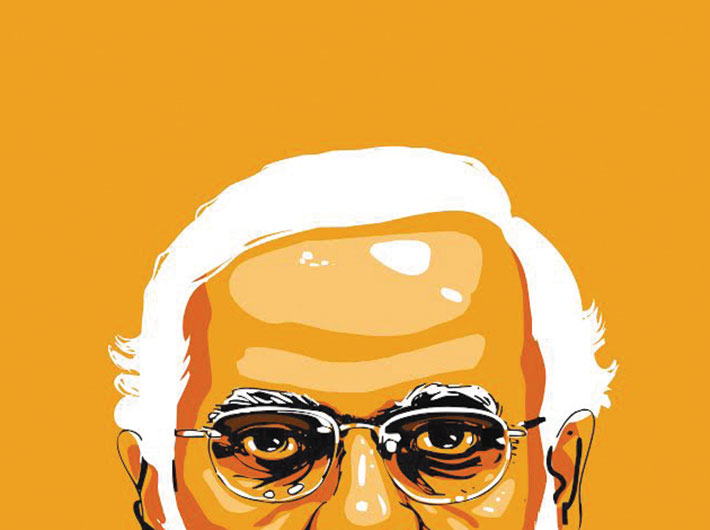Modi has been portrayed as the one-stop solution to all the economic woes the country faces after 10 years of UPA rule. How real are these expectations?
From tackling a sad growth rate and ever-rising inflation to a depressed business environment, Narendra Modi, the BJP’s prime ministerial candidate, has been portrayed as the one-stop solution to all the economic woes the country faces after 10 years of UPA administration.
Also Read:
Expectations of a turnaround in the economy are huge if Modi comes to power but how much will he be able to actually deliver can be debated till the cows come home. While the BJP manifesto does speak about its overall objective of improving economic growth and development, most economists and analysts admit it does not offer enough insight into the party’s economic policies.
According to P Phani Sekhar, fund manager (portfolio management services) at Angel Broking, the most important expectation from Modi as PM is that since he cannot satisfy everybody at once, he should clearly articulate his stance on various things.
“For example, the infrastructure-related stocks have been performing really well recently in the hope that Modi will come to power. They expect that with a stronger and more decisive person at the helm of affairs, the pace of infrastructure development will quicken in the country, just like it did in Gujarat,” Sekhar says. He adds that since Modi has been projected as a pro-business leader, the industry is also hopeful that they will get more relaxations like reduced excise duty so that there is a revival of business growth.
Asked about the turnaround in manufacturing sector, Sekhar says while the industry hopes robust infrastructure facilities will be created, it is also well aware of the difficulties Modi may face in negotiating with states. “That is going to be a tricky area for BJP,” he warns. Highlighting the need for a more flexible labour policy, Sekhar admits that “no government wants to get involved in touchy issues.”
Foreign direct investment has been a bone of contention between BJP and Congress. While BJP has welcomed FDI in all sectors, it continues to resist it in multi-brand retail. “UPA’s confidence vote in 2012 on the issue has compelled BJP to harden its stance on the issue,” Sekhar says.
On macroeconomic policies, he suggests BJP would prioritise growth over inflation as it seems to back the theory of supply constraints being responsible for inflation. “Going by the NDA government’s track record, BJP will be more inclined towards fiscal consolidation. It would look to rationalise certain subsidies to make room for capital expenditure to drive growth,” Sekhar says. As a critical step, he says BJP may release a white paper on the economy, like Mamata Banerjee did when she took charge of the railway ministry in 2009.
According to Indira Hirway, director of the Ahmedabad-based Centre for Development Alternatives (CFDA), the BJP manifesto lists “some good things” but lacks clarity in the ideological statement that reflects a sound development strategy. “There is a clear contradiction between the so-called Gujarat growth model, which focuses mainly on establishment and growth of corporate houses, and the labour-intensive growth path (that the manifesto talks about), promoting small-scale industries and inclusive growth. The two models cannot go together. The Gujarat model, which focuses mainly on economic growth, at almost any cost, believes in achieving high growth through good governance (focused mainly to the needs of the corporate sector), good infrastructure (focused mainly to the needs of the corporate sector) and more importantly through high levels of subsidies, incentives and concessions such as cheap land, cheap water supply and easy access to other natural resources to the corporate sector. This has promoted highly capital-intensive growth in Gujarat along with a highly dualistic growth,” she says.
Bharat Ramaswami, professor (planning unit) at Indian Statistical Institute, agrees that when it comes to economic policies, the BJP manifesto doesn’t say much, so it is not very easy to figure out what they will do. “It is likely that the new government will announce some big-ticket infrastructure projects,” he says. “India has been bogged by slowdown in decision-making and pending approvals to large infrastructure projects. This is one key area Modi will look to make a difference. In fact, improving infrastructure facilities by building more ports, better roads, bridges, internet connectivity, newer cities, etc., is likely to become his signature tune.”
Many, including ratings agencies, seem to believe that an improved business sentiment is possible if Modi does become the PM. Take the instance of global ratings agency Moody’s, which has vouched for Modi in a report released earlier this year. “A Narendra Modi-led BJP government, if elected, should offer a more business-friendly policy that will further support confidence and investment,” says a Moody’s Analytics report. It adds that bad times of the Indian economy are soon to disappear.
“On home front, fewer downside risks, a more competent central bank governor, and prospect of better government after the election have boosted business and investor confidence,” Glenn Levine, chief economist at Moody’s Analytics, had said. Moody’s, Levine said, expects the economy to grow at 5 to 5.5 percent in 2014 before touching 6 percent in the next fiscal.
Unemployment is another worry that has plagued the country for years now, and Hirway argues that a sweeping promise of generating jobs without focusing on overall employment policy of the country is a short-term solution. “It is now nationally and globally accepted that employment per se is not good; it is good only when it is decent, i.e., it is productive and provides good wages, social security and good working and living conditions. This aspect of employment has been ignored in India, and more so in Gujarat. The ‘Gujarat model’ has paid scant attention to the quality of employment, with the result that about 94 percent of Gujarat workforce is unprotected and vulnerable.”
But quality of employment is not even referred to in the manifesto, she says. “It is important to note that Gujarat lags many faster-growing as well as slow-growing states in terms of wages – rural and urban, male and female and casual and regular, according to the last three rounds of NSSO surveys. This model does not seem to be desirable for India. The BJP manifesto does not seem to realise that the ‘good things’ listed in the manifesto are not capable of reaching inclusive, broad-based and fair growth in the country.”
Even on taming inflation, Hirway says there are not major differences between the BJP and Congress about the basic growth path though there will be differences in degree, in attitude and in the commitment to the masses. Inflation is a complex problem and cannot be treated only by the supply side or the demand side interventions and the new government, she says.
Ramaswami says while friction with the Reserve Bank of India is common for every government, the new government will try and give the growth agenda priority over taming inflation in order to sort of boost the domestic investor sentiment.
Moving on to foreign direct investment, while the party has promised to encourage it in various sectors, it seems adamant not to relent in the multi-brand retail sector and this is going to be a serious challenge for Modi, says Ramaswami. “One of the major achievements of Gujarat is the kind of foreign investment it attracts and hence, Modi will be keen to pull off something similar across the country if he becomes PM. However, it is not going to be as easy for him.
On the FDI front, he says, BJP does not have a clear stand on it and the opinion remains divided. Hence, if and when Modi tries to bring in greater foreign investment, “he will face opposition not just outside but will also have to deal with some tension within the party. Also, a lot of these decisions are likely to be guided by what RSS decides. The RSS has been very vocal on its stance to encourage ‘swadeshi’ goods and services and may be a roadblock in getting in ‘videshi’ investments.”
The one major departure, however, from the Congress’s way of doing things is that instead of looking at establishing various rights, the BJP will look at starting various initiatives as programmes, Ramaswami adds. “While they may not scrap programmes like MNREGA, which is already dying a slow death, and food subsidies, they would possibly not expand them. It will also be interesting to see the fate of the Aadhaar programme. My guess is, the BJP will look to transform the role of Aadhaar towards a more explicit national citizenship ID rather than an identity ID.”
“Talking about managing fiscal deficit, disinvestment remained a popular choice for UPA, which boomeranged. The UPA’s idea to go for aggressive disinvestment of public sector enterprises (PSEs) just to be able to achieve the fiscal deficit target is not something the BJP is likely to follow,” says Sanjeev Ahluwalia, former joint secretary, disinvestment and economic affairs. He says the BJP and Modi have never said that they are aggressive about privatising PSEs. “In fact, they will make the public sector much more efficient, as it was during the NDA rule. In Gujarat, the power companies have not been privatised and even in other BJP-ruled states that has been the case.”
The BJP’s approach is to associate development with the private sector, Ahluwalia says. “If they create competition in the market, the public sector will be forced to perform. And even if they do not, they will remain in the public eye. The problem is when you have a large share of the public sector in an industry; private sector uses the lower benchmark of public sector.”
A key change Ramaswami expects, apart from a stronger PMO making big-bang announcements for project clearances and infrastructure development, is a change in the centre-state finances. “Having worked as a chief minister for so many years, Modi has a better sense of realities at the state level. So he is likely to give states more autonomy in deciding the utilisation of funds. He could be more sympathetic towards states and this could mean a reduced role for the planning commission.”
But both Ramaswami and Hirway maintain that the BJP, or even Modi, do not have a magic wand to wish away the evils of the economy overnight.
“The Congress lost a lot of face due to indecisiveness on various issues and the non-transparent manner of making certain decisions,” Ramaswami says. “So, while the BJP may arrive with big-bang announcements and provide a host of clearances to infrastructure projects, the way they execute these ideas will be the key. They too will have to confront issues of financing infrastructure, allocating and auctioning resources, and forming durable public-private partnerships.”
About the possibility of extrapolating the Gujarat model to the rest of India, Hirway says, “The model could be implemented in Gujarat because of various reasons, including absence of a strong opposition party in the state and intolerance to dissent. The situation at the Centre, however, would be very different.”
(This story appeared in the April 16-30 print issue)

